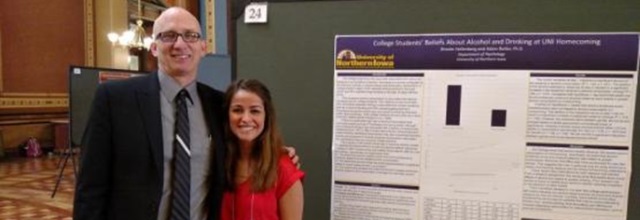Honors Program Theses
Award/Availability
Open Access Honors Program Thesis
First Advisor
Laura Jackson
Keywords
Prairie plants--Seeds--Viability; Prairie plants--Growth;
Abstract
Prairie restorations are expensive and emergence rates as low as ten percent are often observed. This could be because seeds are exposed to dangers from microbial and fungal attack, as well as predation from granivores after planting. Our experiment aimed to determine the post-dispersal seed fates of four native prairie species after they had been planted in the soil and covered with an exclosure to limit vertebrate predation. It was performed in a prairie restoration on the University of Northern Iowa Campus in Cedar Falls, Iowa. I coated five sets of 100 seeds of each species (Elymus canadensis, Oligoneuron rigidum, Eryngium yuccifolium, and Desmodium canadense) with fluorescent Glogerm™ and planted them at a depth of five millimeters in four rows (one row of 100 seeds per species, per exclosure) inside five wire mesh exclosures. After five weeks, seedling emergence data was collected and the top layer of soil from each row was excavated from within the exclosures. Collected soil was examined under a UV lamp and recovered seeds were tested for viability. I hypothesized that a majority of the seeds planted would be recovered, and that most of those recovered would be viable. Seed fates differed among the four species and were identified as emerged in the field, died during emergence, viable, and non-viable. Only 10-27% of the seeds planted were accounted for after the first recovery date and 4-10% after the second, and the majority tested were non-viable. Out of those recovered, 39% emerged as seedlings with D. canadense and E. canadensis demonstrating the highest emergence rates of the four species. It is evident that finding seeds after planting is still an obstacle that must be overcome in order to better understand post-dispersal seed fates.
Year of Submission
2014
Department
Department of Biology
University Honors Designation
A thesis submitted in partial fulfillment of the requirements for the designation University Honors
Date Original
2014
Object Description
1 PDF file (vii, 26 pages)
Copyright
© 2014 Paige Leytem
Language
EN
File Format
application/pdf
Recommended Citation
Leytem, Paige, "Using seed recovery methods to determine causes of failed germination in native prairie species" (2014). Honors Program Theses. 150.
https://scholarworks.uni.edu/hpt/150



